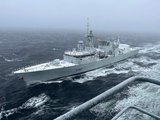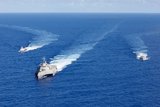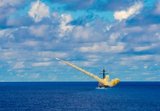Rolls-Royce wins USCG OPC propulsion contract
Rolls-Royce will deliver propulsion equipment for the US Coast Guard's Offshore Patrol Cutters (OPCs) under a contract with the Eastern Shipbuilding Group, the company announced on 28 February.
The company will supply equipment for the fleet's first nine vessels under the contract, with an option to add two more.
Rolls-Royce will supply controllable pitch propellers, shaft lines and Promas rudders, bow thrusters, steering gear, fin stabilisers and MTU marine generator sets. The four EPA Tier 3 compliant MTU 12-cylinder Series 4000 (1000kW) generator sets will provide each vessel with electrical and loiter propulsion power.
The new vessels will replace the USCG's fleet of Medium Endurance Cutters, providing a capability bridge between the National Security Cutter fleet and the Fast Response Cutter fleet. Construction of the OPCs will begin in 2018 with delivery of the first vessel scheduled for 2021.
Sam Cameron, senior vice president, sales and business development, Rolls-Royce, said: 'The OPC is the US Coast Guard's largest shipbuilding programme and we are extremely proud to be confirmed as a major supplier to Eastern Shipbuilding Group on a project that will transform future capability.
'This contract marks one of the most comprehensive Rolls-Royce systems packages ever to be selected for a coast guard vessel, and we're looking forward to delivering and integrating our marine technology into this new and highly capable ship.'
More from Naval Warfare
-
![US Navy to conduct an experimentation campaign with emerging tech in 2026 and 2027]()
US Navy to conduct an experimentation campaign with emerging tech in 2026 and 2027
The Technology Operational Experimentation Events will inform future requirements as the US Navy looks for innovative solutions across three key operational domains.
-
![US Navy to acquire micro-uncrewed underwater vehicles for ISR and coastal data collection]()
US Navy to acquire micro-uncrewed underwater vehicles for ISR and coastal data collection
The Naval Supply Systems Command is seeking authorised resellers of JaiaBot uncrewed underwater vehicles and multivehicle pods. The platforms will support undergraduate education at the US Naval Academy.
-
![NATO tests use of “undetectable, jam-proof” laser communication in maritime scenarios]()
NATO tests use of “undetectable, jam-proof” laser communication in maritime scenarios
As part of its effort to better prepare its capabilities for operations in contested and congested scenarios, NATO evaluated a Lithuanian ship-to-ship terminal designed to not be susceptible to enemy interference.
-
![US Navy advances with the Harpoon Service Life Extension Programme]()
US Navy advances with the Harpoon Service Life Extension Programme
The US Navy plans to improve Harpoon’s anti-ship and land attack capabilities by equipping the missiles with sensors and technologies required for succeeding in future battlespace.






















